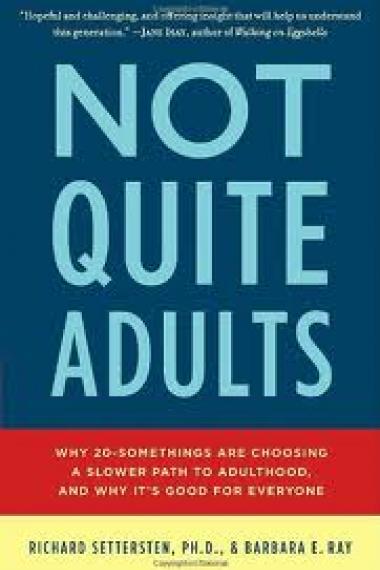Constantly in need of new and more terrifying copy, news editors and television producers reach for that evergreen tale—cultural details slightly modified—of America’s disillusioned youth. From zoot suit rioters to punk rockers, grunge acolytes to goth kids, the specter of the coming generation’s apathy and aimlessness, political disengagement and social alienation, continues to alarm parents and financially motivated experts. Today, the problem is the so-called Peter Pan generation of Millennials. Headlines lament that more kids are living at home after high school, waiting to marry, and racking up student loans.
But in Not Quite Adults, a book that distills eight years of research supported by the MacArthur Research Network on Transitions to Adulthood, Oregon State University sociologist Richard Settersten and Barbara E. Ray, former communications director for the network, argue that kids aren’t simply dragging their heels about growing up. Mining a pile of data from government surveys and other sources, as well as more than 500 interviews conducted with subjects between the ages of 18 and 34, Settersten and Ray conclude that the “traditional milestones” of adulthood—including quickly leaving the parental nest, getting a job, and marrying and having children—have moved back, and that there are significant financial advantages to ambling toward adulthood.
While busting myths about the harmful effects of “helicopter” parenting (it gets a bad rap) and questioning the frequent hand-wringing about the “death of marriage” (putting off wedlock and parenthood helps young people earn a degree), Settersten and Ray devote considerable attention to the American view of higher education. They’re skeptical of our one-size-fits-all model that prescribes bachelor’s degrees for everyone. Nearly half of students fail to graduate within six years of enrolling in college, thus assuring that they exit without a degree but burdened by sizable debts. The authors make the politically incorrect and undeniably true argument that some students simply aren’t cut out for a four-year university (one interviewee chose a college based on the availability of parking) and would be better served by vocational or technical training.
Those who are ready for college, Settersten and Ray contend, should stop gaping at the steep price tag of many institutions and, in light of the vastly higher salaries earned by workers with advanced degrees, view college debt as an investment. It’s true that the typical student who graduates with debt from a public university—where the cost of tuition, room, and board grew 67 percent between 1987 and 2008—owes $20,000. But installments on that debt are equivalent to a monthly car payment, and the value of an education lasts a lot longer than that of a car.
That said, the authors suggest that parents seek détente in the education “arms race” of elevated expectations that goads them to overextend their resources in order to launch their kids into the “top tier.” But they offer no concrete suggestions for how this goal could be achieved other than to say that the country needs “education reform” at the primary level—though whether this means more charter schools and voucher programs, higher teacher pay, or some other remedy isn’t clear.
Settersten and Ray conclude with a number of surprisingly banal prescriptions for the problems Millennials face. It seems obvious that young people should choose their friends wisely, lest they be influenced by rogue peers. It is undeniable that today’s young adults are “creating communities of like minds” and “want freedom and autonomy.” “In the past,” the authors write, “dating eventually led to sex. Today, sex eventually leads to dating.” Yet Millennials are also holding out for a partner who is a “best friend or a soul mate.” None of this would be out of place in a book about the purportedly indifferent Generation X-ers who preceded them, or unfamiliar to those who came of age in the 1980s.
Still, Settersten and Ray have produced an occasionally interesting—and consoling—account of a supposedly troubled generation. And when Millennials reluctantly acquiesce to adulthood, the same concerns will likely be applied to the next generation.

